What do you know about the acceptance and approval status of new food raw materials in China between 2018 and 2022? In this article, our food expert will take you to more detailed information about the registration status of new food raw materials in China.
Statistics of new food raw material applications accepted in the last five years
From 2018 to 2022, the National Health Commission (NHC) officially accepted a total of 68 new food raw materials, of which 47 were domestic and 21 imported. The statistics of applications accepted in specific years are shown in Figure 1.
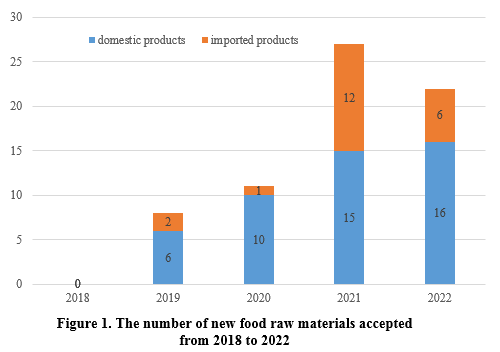
Statistics of new food raw material released for public comments in last five years
From 2018 to 2022, a total of 26 new food raw materials have passed the technical review of the expert review committee, and the National Center for Food Safety Risk Assessment (CFSA) has publicly solicited opinions, including 18 new raw material varieties and 8 new microbial varieties (including two strains that can be used in food and six strains that can be used in infant food). The statistics of new food raw materials issued for public opinion in specific years are shown in Figure 2.
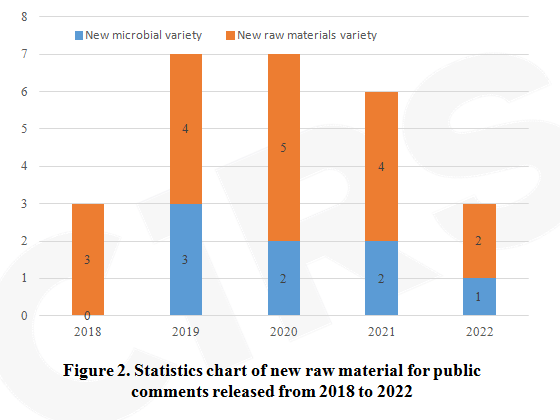
Statistics of approved new food raw material in last five years
From 2018 to 2022, a total of 22 new food raw materials have been approved by the NHC, including 15 new food raw material varieties and sevennew microorganism varieties (including two strains that can be used in food and five strains that can be used in infant food). The statistics of approved new food raw materials in specific years are shown in Figure 3 (in terms of release time), and the approved new food raw materials are listed in Table 1.
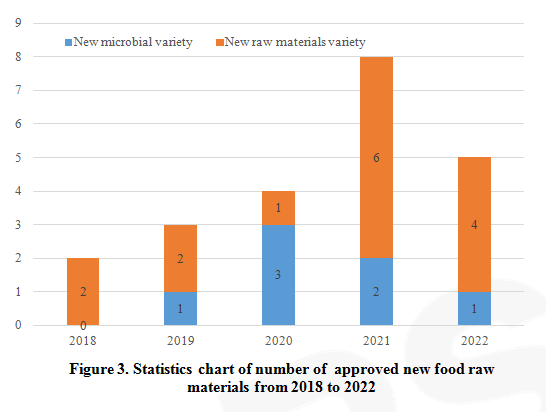
Table 1. List of approved new food raw materials in 2018-2022
|
Acceptance Date |
Acceptance Number |
Name |
|
26/09/2018 |
No.10,2018 |
Black chokeberry |
|
26/09/2018 |
No.10,2018 |
Nostoc sphaeroides |
|
29/05/2019 |
No.2,2019 |
Lactobacillus curvatus |
|
29/05/2019 |
No. 2 , 2019 |
Ashitaba stem and leaf |
|
29/05/2019 |
No.2,2019 |
Loquat flower |
|
02/06/2020 |
No.4,2020 |
Lactobacillus helveticus R0052* |
|
02/06/2020 |
No.4,2020 |
Bifidobacterium infantis R0033* |
|
02/06/2020 |
No.4,2020 |
Bifidobacterium bifidum R0071* |
|
02/06/2020 |
No.4,2020 |
Penthorum chinense Pursh. |
|
07/01/2021 |
No.9,2020 |
Isaria cicadae Miq. fruit body (artificial cultivation) |
|
07/01/2021 |
No.9,2020 |
Sodium Hyaluronate |
|
07/01/2021 |
No.9,2020 |
Lactobacillus kefiranofaciens subsp. kefiranofaciens |
|
25/04/2021 |
No.5,2021 |
β-1,3-/α-1,3-glucan |
|
25/04/2021 |
No.5,2021 |
Dihydroquercetin |
|
25/04/2021 |
No.5,2021 |
Lactobacillus rhamnosus MP108* |
|
25/04/2021 |
No.5,2021 |
Nannochloropsis gaditana |
|
22/10/2021 |
No.9,2021 |
Rumexpatientia L. ×Rumextianshanicus A. Los |
|
01/03/2022 |
No.1,2022 |
Kanzan flower |
|
01/03/2022 |
No.1,2022 |
Pyrroloquinolinequinonedisodium (PQQ) salt |
|
11/05/2022 |
No.2,2022 |
Chlamydomonas reinhardtii |
|
11/05/2022 |
No.2,2022 |
Bifidobacterium longum subsp.longum BB536* |
|
11/05/2022 |
No.2,2022 |
Sugarcane Polyphenols |
|
*Note: This substance is approved for use in infant and young child food. |
||
List of products received a termination review in the last five years
From 2018 to 2022, there are a total of 31 new food ingredients were included in the termination review list by the NHC. Statistics on the number of terminated reviewed products in specific years are shown in Figure 4. For companies applying for new food materials, it is also a way to obtain approval by getting the results of the examination of "common food", "substantial equivalence", and "local traditional eating habits". The detailed analysis is shown in Figure 5.
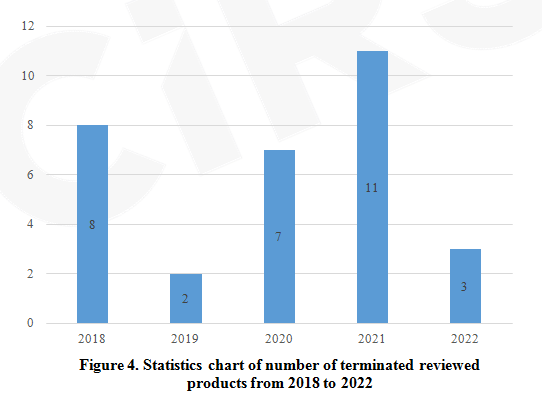
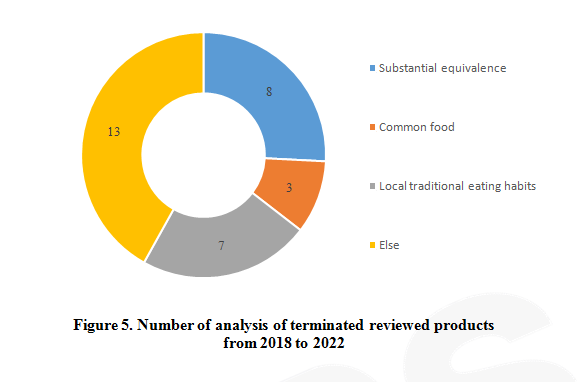
If you need any assistance or have any questions, please get in touch with us via service@hfoushi.com.
Further Information


